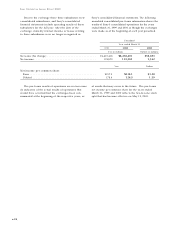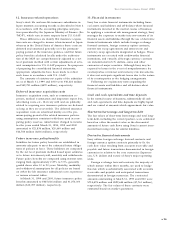Sony 2000 Annual Report Download - page 71
Download and view the complete annual report
Please find page 71 of the 2000 Sony annual report below. You can navigate through the pages in the report by either clicking on the pages listed below, or by using the keyword search tool below to find specific information within the annual report.
SONY CORPORATION ANNUAL REPORT 2000
69
picture or television series first becomes available for
telecast. Revenue from home videocassette sales is
generally recognized on the date of shipment.
Insurance premiums are reported as revenue when
due from policyholders. Benefits and expenses are
associated with earned insurance premiums so as to
result in the recognition of profits over the life of the
contracts. This association is accomplished through a
provision for liabilities for future benefits and amortiza-
tion of acquisition costs.
Cash and cash equivalents
Cash and cash equivalents include all highly liquid
investments, generally with original maturities of three
months or less, that are readily convertible to known
amounts of cash and are so near maturity that they
present insignificant risk of changes in value because
of changes in interest rates.
Marketable securities
Marketable securities consist of debt and equity securi-
ties. Debt securities and equity securities designated as
available-for-sale, whose fair values are readily deter-
minable, are carried at fair value with unrealized gains
or losses included as a component of accumulated other
comprehensive income, net of applicable taxes. Debt
and equity securities classified as trading securities are
carried at fair value with unrealized gains or losses
included in income. Debt securities that are expected
to be held-to-maturity are carried at amortized cost.
Individual securities classified as either available-for-sale
or held-to-maturity are reduced to net realizable value by
a charge to income for other than temporary declines in
fair value. Realized gains and losses are determined on
the average cost method and are reflected in income.
Inventories
Inventories in electronics, game and music are valued at
cost, not in excess of market, cost being determined on
the “average cost” basis except for the cost of finished
products carried by certain subsidiary companies which
is determined on the “first-in, first-out” basis.
Film costs include production, print, certain advertis-
ing costs and allocated overhead. Film costs are amor-
tized in the proportion that revenue for a period relates
to management’s estimate of ultimate revenues.
Unamortized film costs are compared with estimated
net realizable value on an individual film basis and
write-downs are recorded when indicated. Film costs
for motion pictures and television programs that are
expected to be amortized against revenues from primary
markets are classified as current assets. Primary markets
for motion pictures include theatrical, home videocas-
sette and pay television. Primary markets for television
programs include network and first-run syndication. All
other film costs are classified as noncurrent.
Property, plant and equipment and depreciation
Property, plant and equipment are stated at cost. Depre-
ciation of property, plant and equipment is principally
computed on the declining-balance method for Sony
Corporation and Japanese subsidiaries and on the straight-
line method for foreign subsidiary companies at rates
based on estimated useful lives of the assets, principally,
ranging from 15 years up to 50 years for buildings and
from 2 years up to 10 years for machinery and equip-
ment. Significant renewals and additions are capitalized
at cost. Maintenance and repairs, and minor renewals
and betterments are charged to income as incurred.
Intangibles and goodwill
Intangibles, which mainly consist of artist contracts,
music catalogs and trademarks, are being amortized on
a straight-line basis principally over 16 years, 21 years
and 20 years, respectively.
Goodwill recognized in acquisitions accounted for as
purchases is being amortized on a straight-line basis
principally over a 20 or 40-year period.
Sony evaluates the amortization period of intangibles
and goodwill on an ongoing basis in light of changes in
any business conditions, events or circumstances that
may indicate potential impairment of those assets.
Deferred insurance acquisition costs
Costs that vary with and are primarily related to acquir-
ing new insurance policies are deferred as long as they
are recoverable. The deferred insurance acquisition
costs are being amortized mainly over the premium-
paying period of the related insurance policies using
assumptions consistent with those used in computing
policy reserves.
Future insurance policy benefits
Future insurance policy benefits are computed based on
actuarial assumptions.
Accounting for the impairment of long-lived assets
Long-lived assets, certain identifiable intangibles, and
goodwill related to those assets to be held and used are
reviewed for impairment whenever events or changes
in circumstances indicate that the carrying amount of
the assets may not be recoverable. When the sum of
expected future cash flows (undiscounted and without
interest charges) is less than the carrying amount of the
asset, an impairment loss is recognized, based on the
fair value of the asset. The fair value of goodwill is
determined using a discounted cash flows analysis.
Goodwill not identified with assets that are subject to
an impairment loss is evaluated by using discounted
cash flow method.
























